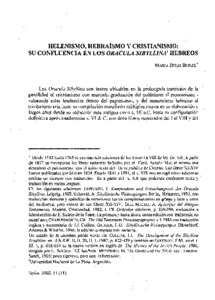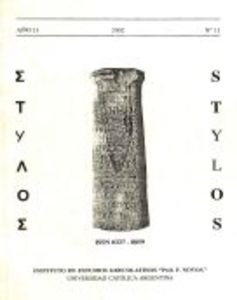Por favor, use este identificador para citar o enlazar este ítem:
https://repositorio.uca.edu.ar/handle/123456789/11479| Campo DC | Valor | Lengua/Idioma |
|---|---|---|
| dc.contributor.author | Buisel de Sequeiros, María Delia | es |
| dc.date.accessioned | 2021-05-05T12:53:10Z | - |
| dc.date.available | 2021-05-05T12:53:10Z | - |
| dc.date.issued | 2002 | - |
| dc.identifier.citation | Buisel, M. D. Helenismo, hebraísmo y cristianismo: su confluencia en los Oracula Sibyllina hebreos [en línea]. Stylos. 2002 (11). Disponible en: https://repositorio.uca.edu.ar/handle/123456789/11479 | es |
| dc.identifier.issn | 0327-8859 | - |
| dc.identifier.uri | https://repositorio.uca.edu.ar/handle/123456789/11479 | - |
| dc.description.abstract | Resumen: Los o.s. son doce libros cuya composición va desde el s. III a.e. hasta el s. VI d.C.; los integran elementos hebreos, greco-romanos y cristianos. Sobre una base hebraica con máscara griega e interpolaciones cristianas que van del monoteísmo al trinitarismo, el yo autoral, una supuesta profetisa, la Sibila, vaticina el desarrollo de la historia humana como una serie de imperios con su apogeo y desaparición; esta serie NO es cíclica como en el pensamiento grecolatino, tiene un comienzo, un despliegue y un término en el Juicio Final con una visión apocalíptica de conflagración total. Esto incluye un discurso político subyacente emitido por las comunidades judías helenizadas de Alejandría contra sus ocasionales dominadores, además de un discurso salvífico cristiano propio de los interpoladores, ambos entrecruzándose en boca de la Sibila. | es |
| dc.description.abstract | Abstract: The Oracula Sibylina are twelve books, whose composition goes by from III century b. C. to VI century a. C.; Hebrew, Greek-roman and Christian elements make up them. Over a Hebraic ground with Greek mask and Christian interpolations that go from monotheism to trinitarism, the authorial ego, a supposed prophetess, the Sybil, foretells the development of the human history as a series of empires with his height and disappearance; this series is not cyclic as in the Greek and Roman thought; it has a beginning, an Wlfolding and an end in the Last Judgement with an apocalyptic sight of whole conflagration. This encloses a potitical speech in the underground sent forth by the Jew hellenized communities of Alexandria against his incidental dominators; moreover we must add up a Christian speech of salvation,the own speech of interpolators, where both interweave in the Sibyl's mouth. | es |
| dc.format | application/pdf | es |
| dc.language.iso | spa | es |
| dc.publisher | Universidad Católica Argentina. Facultad de Filosofía y Letras. Instituto de estudios grecolatinos "Prof. F. Nóvoa" | es |
| dc.rights | Acceso abierto | * |
| dc.rights.uri | http://creativecommons.org/licenses/by-nc-sa/4.0/ | * |
| dc.source | Stylos Nº 11, 2002 | es |
| dc.subject | LITERATURA CLASICA | es |
| dc.subject | LITERATURA HEBREA | es |
| dc.subject | HISTORIA ANTIGUA | es |
| dc.subject | CRISTIANISMO | es |
| dc.subject | HELENISMO | es |
| dc.title | Helenismo, hebraísmo y cristianismo: su confluencia en los Oracula Sibyllina hebreos | es |
| dc.type | Artículo | es |
| uca.disciplina | LITERATURA | es |
| uca.issnrd | 1 | es |
| uca.affiliation | Fil: Buisel, María Delia. Universidad Nacional de La Plata; Argentina | es |
| uca.version | publishedVersion | es |
| item.languageiso639-1 | es | - |
| item.grantfulltext | open | - |
| item.fulltext | With Fulltext | - |
| Aparece en las colecciones: | STY - 2002 nro. 11 | |
Ficheros en este ítem:
| Fichero | Descripción | Tamaño | Formato | |
|---|---|---|---|---|
| helenismo-hebraismo-cristianismo.pdf | 2,16 MB | Adobe PDF |  Visualizar/Abrir | |
| tapa.jpg | 4,02 kB | JPEG |  Visualizar/Abrir |
Visualizaciones de página(s)
163
comprobado en 27-abr-2024
Descarga(s)
1.056
comprobado en 27-abr-2024
Google ScholarTM
Ver en Google Scholar
Este ítem está sujeto a una Licencia Creative Commons

